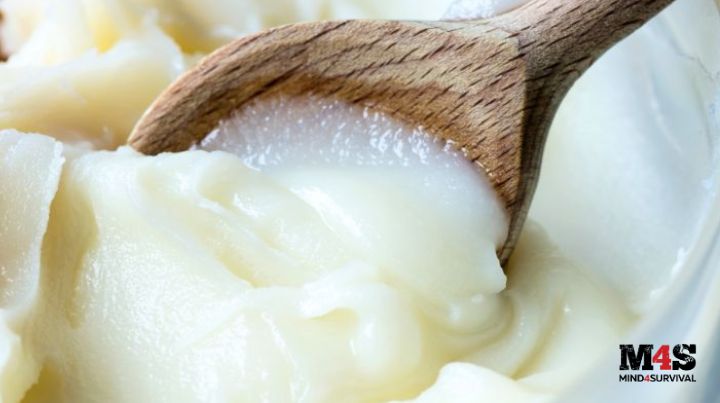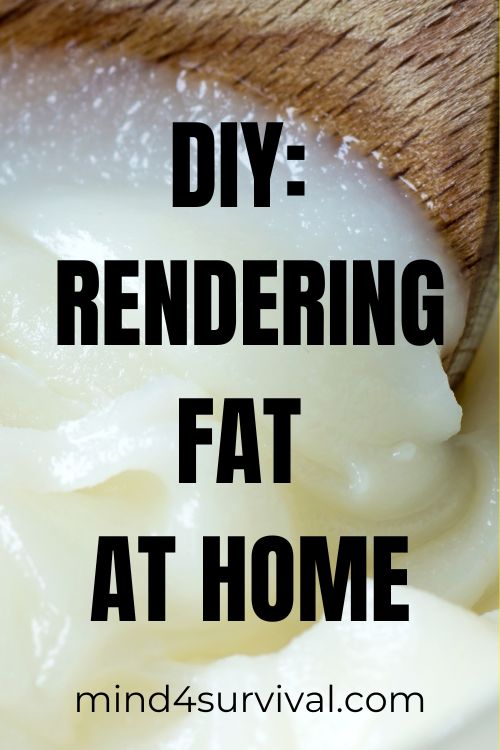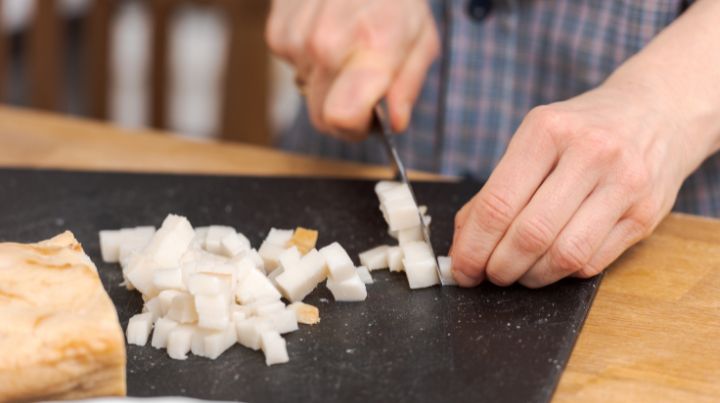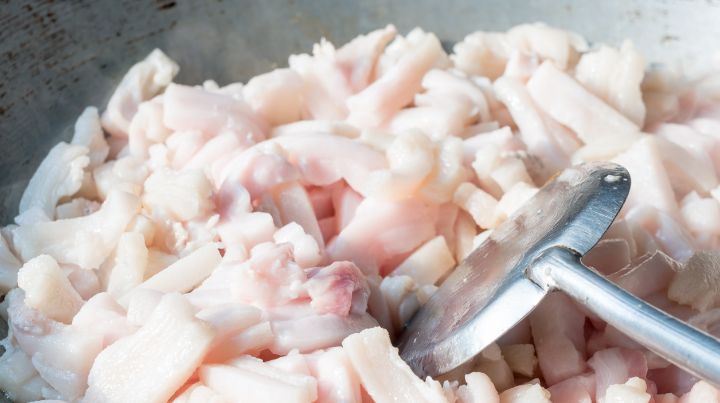DIY: Rendering Fat at Home

The pace of food inflation is leveling off, but prices remain high. Increasing numbers of Americans buying food at dollar stores is not a promising scenario. Unless your income is rising faster than your expenses, you’re probably thinking about what you can do to bring your household expenditures down.
We talk a lot about growing your own vegetables and raising your own meat, and these are worthwhile endeavors. But most of us also like to cook our meat and veggies in some kind of fat. Not only does this improve the flavor, but fat also provides all kinds of fat-soluble vitamins.
Unfortunately, fat is also under more pressure than other foods in terms of price inflation because edible oils have all kinds of industrial uses. President Biden’s Sustainable Aviation Fuel Grand Challenge and Europe’s Renewable Energy Directive incentivize industries to use edible oils in biofuels because they are considered “sustainable.”
We won’t argue about the truth behind “sustainability” in this article. We’re just going to talk about how you can keep healthy fats in your diet despite the increased industrial demand for beef, pig, and chicken fat driving up prices. As animal fats are increasingly used by industry, cheaper oils will probably be substituted in many foods. Because of the increased demand, these cheaper oils will probably become less cheap, as well.
However, you may be throwing away usable fat without really thinking about it. You might think of that jar of canola oil or stick of vegetable shortening as something irreplaceable without industrial equipment, but that’s not the case. You can make most of your household’s fat with no fancier equipment than knives and a crockpot.
Where to Obtain Fat
To end up with lard or tallow that you can scoop out of a jar in your fridge, you start with slabs of fat. Lard is made from pig fat, while tallow is made from the fat of beef or lamb. If you are wondering where to get slabs of fat, I have seen them for sale in butcher sections of ethnic grocery stores.
Alternatively, if you are already in the habit of buying entire animals at a time from a farmer, you can ask the processor to throw in some large pieces of fat. This is what I do when I get pigs processed. It doesn’t cost anything extra, and if you are already in the habit of buying entire animals, this is worth looking into. With the increase in prices of edible oils, rendering your own fat can potentially save you a lot of money.
If you don’t live near an ethnic grocery store, and you’re used to buying cheap pieces of meat one meal at a time, look carefully at the meat you buy. A lot of cheaper cuts of meat will have a fair amount of fat, and sometimes, it’s pretty easy to trim off. For example, shoulder steaks are usually fatty. So if I plan to make something with shoulder steaks, I’ll slice off a lot of the fat, put it in a Ziploc bag, and store it in the freezer. Once I have a good amount saved up, I thaw it and then render.
How to Render Fat
You can render fat in a crockpot. It’s easy; it just takes a long time. It also has a strong smell, so I usually do it on days when I can crack the windows in the kitchen and get some fresh air.
Start by slicing the fat into pieces no thicker than a quarter inch. Then, put the sliced fat in the crockpot with about half a cup of water and set the crockpot on low. You’ll need to leave it for at least eight hours, sometimes ten. You just have to check periodically and break up any pieces of fat still sticking together near the end. When the fat is melted, it’s ready to filter.
To filter, put a strainer over a large heat-proof measuring cup. The 4-or 8-cup Pyrexes most grocery stores carry are perfect for this. Then put a cheap coffee filter over the strainer. Don’t use one of those expensive ChemEx filters for this; use the cheapest filter at your grocery store, or else it will take forever for the melted fat to drip through.
After your melted fat has made it through the filter and strainer, pour it into a glass jar and put it in the refrigerator. I have kept rendered, filtered fat in the fridge for close to a year.
You can also freeze rendered fat, though it won’t keep as long in the fridge after it’s been frozen. To use lard that’s been frozen, simply slice off a chunk that you’re pretty sure you’ll use within two weeks and put that in the fridge.
How Do I Use It?
If you’ve been rendering pig fat, the leftover bits of cooked fat in the crockpot are the cracklings. Hot and salted, they are pretty tasty.
You can substitute lard for vegetable shortening in pie crusts and baked goods like muffins or cookies. If you’ve patiently filtered it, the flavor is very mild. I haven’t used vegetable shortening for baked goods in years; I use lard all the time, and no one at any party, bake sale, or church luncheon has ever noticed the difference. You can also use lard to brown meat, saute vegetables, or grease pans. It’s extremely versatile.
Tallow is best used for browning meat or cooking vegetables. Part of this is because tallow has a stronger flavor; part, too, is because the chemical structure is different than lard’s. They don’t work exactly the same in baked recipes. I have tried this myself and learned the hard way. If you ever have both fats, it’s pretty obvious: tallow becomes rock-hard in the fridge. Refrigerated lard is firm but not stiff. Having said that, tallow is still very nutritious and delicious in savory recipes.
What About Vegetarian Oils?
In case you are wondering about vegetarian oils, you can press oilseeds at home, but this involves expensive equipment. The Dutch-made Piteba oil press has good reviews but costs almost $200. If you are passionately opposed to eating meat or are already growing a seed crop like sunflowers at scale, this might be a good buy. Likewise, if you live near olive groves or in a tropical area with access to coconut trees, looking into traditional methods of extracting those oils might be worth the effort, too.
However, if you live in a temperate climate, if you’re not growing oilseed crops, if you just want to save money and use the food you have more efficiently, turning scraps of animal fat into usable lard or tallow probably won’t require spending any extra money.
Why Bother?
First of all, waste not, want not. Americans used to think like that, especially during the time of the Founding Fathers.
Unfortunately, modern living has turned Americans into some of the world’s worst food wasters. And more unfortunately still, since many of us were raised with the assumption that the U.S. would be permanently wealthy, many thriftier habits that would have been considered normal 100 years ago have now been lost.
Don’t let saving every last bit of food make you feel like you’re poor or stingy. Cooking even simple foods like potatoes and beans in animal fat will give them a much richer flavor than cooking them in the cheapest oil from the store. Considering some of the rather nasty chemicals that go into producing cheap vegetable oils, home-rendered animal fats are healthier for you, too.
Most of us can’t do anything about competing with various industries for food products. If prices go up, they go up. But, by thinking about how our great-grandparents probably did things, we may be able to use the food we have more efficiently.
Additional Resources:
- Meat Storage for When There Is No Freezer
- Edible Landscaping: Food Hidden in Plain Sight
- CSA Farmshares: Could One Be Right For You?
- Food Preservation: Fermentation

Don't Miss Out!
Join the thousands of people who rely on Mind4Survival preparedness advice by subscribing to our FREE newsletter.
- Practical preparedness information
- Zero Spam
- < 0.25% of people unsubscribe




Join Mind4Survival!
Stay informed by joining the Mind4Survival! 100% Secure! 0% Spam!
Follow Us!
Affiliate Disclosure
Mind4Survival is a free, reader-supported information resource. If you make a purchase through our link, we may, at no cost to you, receive an affiliate commission.



